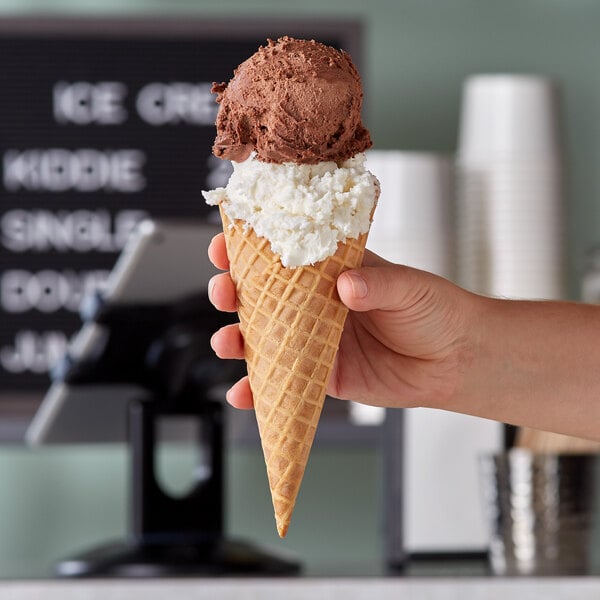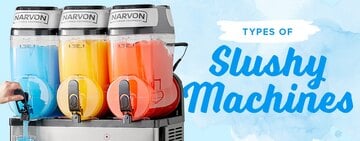Types of Frozen Desserts
If you’re planning to open an ice cream shop or hoping to serve refreshments at a pool-side concession stand, frozen desserts are likely to be the highlight of your menu. Customers look for refreshing snacks on hot summer days, so you can boost your bottom line by offering a variety of frozen treats. We created a list of frozen desserts so you can find options to expand your dessert or ice cream parlor menu.
Shop All Ice Cream SuppliesUse these links to learn more about a specific frozen dessert:
Frozen Desserts List
Find frozen treats your customers will love by trying some of the frozen desserts on our list. We identify their differences and what equipment is used to make them below. As a general rule, adding pectin to fruity frozen desserts improves their quality.
1. Ice Cream

Ice cream is a staple of summertime and a regular on dessert menus. You can find ice cream in pre-packaged individual cartons, or you can make unique flavors to put in bins for your dipping cabinet. This creamy frozen treat is a great option for ice cream parlors, restaurants, diners, boardwalk shops, and ice cream trucks.
- What Is Ice Cream Made Of? Ice cream is a frozen dairy dessert made of milk or cream, ice, and sugar. Flavoring syrups or powders can be added to the mix to create different flavor options. To be considered ice cream, the dessert must contain 10% - 16% butterfat.
- Best Machine For Ice Cream - Ice Cream Makers and Batch Freezers: An ice cream maker churns the ingredients together while incorporating air into the mixture to give the final product a light mouthfeel. This creates a creamy and dense final product that can be scooped onto an ice cream cone or into a bowl.
2. Custard

Frozen custard is a decadent frozen dessert that can often be found at amusement parks, boardwalks, and burger joints. This thick and creamy frozen dessert can be dispensed into cones or bowls and combined with other frozen desserts like Italian ices and slushies to create a versatile treat for your business.
- What Is Frozen Custard? Custard is made by combining cream, ice, sugar, and egg yolks for emulsification. To be considered frozen custard, the mixture must contain a minimum of 10% milkfat and 1.4% egg yolk by weight.
- Best Machine For Custard - Frozen Custard Machine (Modified Continuous Freezer): The mixture of milk, sugar, and egg yolk is put into a gravity-fed machine that churns slowly and only for approximately 2-3 minutes so a limited amount of air is blended into the recipe. This gives the frozen custard a dense mouthfeel. Depending on the storage temperature, frozen custard can be scoopable like ice cream or dispensed like soft serve.
Custard vs Ice Cream
Although frozen custard and ice cream are made with the same base ingredients (milk, ice, sugar), the difference between custard and ice cream is egg yolks. Frozen custard has a minimum of 1.4% egg yolk by weight while ice cream will have little to no egg in the recipe. Custard has less air churned into the mixture than ice cream, giving it a denser and creamier mouthfeel than ice cream.
3. Soft Serve

Soft serve ice cream, also known as “soft ice” or "soft serve", has a light consistency, which makes it a popular option on frozen dessert menus for customers on the go. This refreshing summer treat can often be found in ice cream trucks, shopping centers, amusement parks, and on boardwalks. When dispensed, soft serve forms a visually pleasing twist that is sure to draw in customers.
- What Is Soft Serve Ice Cream? Soft serve mix is made of cream, ice, and sugar, but only features 3% - 6% milkfat. Air is introduced in the mixing process to keep the recipe light and smooth. Flavoring syrups can also be added in the churning process to create a variety of options.
- Best Machine For Soft Serve - Soft Serve Machine: These gravity-fed units store the soft serve mixture at 25 degrees Fahrenheit to keep it soft while incorporating air by constantly churning the mix. The soft serve ice cream is then dispensed directly into the customer’s cone or bowl by the pull of a lever.
Soft Serve vs Ice Cream
The difference between soft serve and ice cream is that soft serve has a lighter texture and mouthfeel than ice cream. Soft serve features less fat and more air than ice cream. The mix is also constantly turning and dispensed directly from the machine, while ice cream is placed in tubs and hand-scooped. While ice cream is stored at 20 degrees Fahrenheit, soft serve is stored at 25 degrees Fahrenheit to keep its consistency soft.
Custard vs Soft Serve
Although soft serve ice cream and frozen custard can both be dispensed from a machine directly into a cone or bowl, they do have some key distinguishing factors. The difference between custard and soft serve is that custard contains egg yolks while soft serve does not. Because of this, custard has a denser texture and mouthfeel than soft serve.
4. Frozen Yogurt

Provide a refreshing treat for your customers by adding frozen yogurt to your menu. Frozen yogurt, commonly known as “froyo” or “fro-yo”, is a light and tangy frozen dessert, most commonly associated with shopping centers and beach towns. Frozen yogurt shops offer a variety of flavors and ice cream toppings that customers can mix together to create customized bowls. Most froyo shops have customers pay by the weight of their filled bowl using a food scale.
- What Is Frozen Yogurt? Frozen yogurt is a frozen dessert made with yogurt (or cultured milk), cream, ice, and sugar. Because of the yogurt, this treat has a tangy flavor and a creamy consistency without being high in fat. There is no minimum fat requirement for frozen yogurt. It can also be made in a wide array of flavors and is usually paired with tart fruit flavors that complement the tanginess of the original base.
- Best Machine For Frozen Yogurt - Frozen Yogurt Machine: When frozen yogurt mix is added to a frozen yogurt machine, the mixture is rapidly cooled as air is incorporated into the mix. Frozen yogurt is dispensed from the machine into the customer’s cup. Some locations will have units directly accessible to customers so they may fill their cups with the quantity and flavors they would like.
Frozen Yogurt vs Ice Cream
The difference between frozen yogurt and ice cream comes down to their ingredients and consistency. Frozen yogurt contains yogurt or cultured milk, while ice cream only contains plain milk. Ice cream has a more solid consistency that can be scooped, while frozen yogurt is lighter and softer and must be dispensed from a machine. Ice cream also requires a minimum of 10% - 16% butterfat, but frozen yogurt does not have a requirement.
Frozen Yogurt vs Custard
The difference between frozen yogurt and custard is that custard has egg yolks in it and frozen yogurt has yogurt or cultured milk. Custard is denser than frozen yogurt and features a higher fat content. Frozen yogurt has the reputation for being a healthier option because it is low fat and contains probiotics from the yogurt.
Soft Serve vs Frozen Yogurt
The difference between soft serve and frozen yogurt is that soft serve is made with milk and has a sweet flavor, while frozen yogurt is made with yogurt and has a tangy flavor. Soft serve ice cream and frozen yogurt are very similar in appearance and consistency since air is incorporated in both of their mixtures. They can both be dispensed directly from the machine into the customer’s bowl.
5. Gelato

Add an Italian touch to your menu by offering your customers some gelato options. This refreshing frozen treat is known for its array of flavors and eye-catching presentations in a gelateria. Gelato ice cream parlors are popular for making mounds of colorful gelatos using gelato mix. Gelato tubs are then garnished with their corresponding fruit wedges, aromatic herbs, and bars of chocolate for an impressive display. Gelato is an excellent option for the menus of fine dining restaurants, chic cafes, and beach-town boardwalks.
- What Is Gelato? Gelato is made using milk, cream, ice, and sugar. Fruit flavorings, nut butter, and fresh herbs can also be added to achieve vibrant flavors and bold colors. It contains 3.25% - 8% butterfats and 12% - 16% sugar.
- Best Machine For Gelato - Gelato Machines: A gelato maker lightly whips air into the gelato mix during the freezing process to give it a rich mouthfeel. The gelato is dispensed from the machine into a bin which is then stored in a dipping cabinet at 15 degrees Fahrenheit to keep it nice and soft for scooping.
Gelato vs Ice Cream
Gelato and ice cream are both scoopable frozen dairy desserts made with dairy and cream, but the ratios of these ingredients set them apart. The difference between ice cream and gelato is that ice cream contains a minimum of 10% fat, while gelato only features 3.25% - 8% fat. Gelato is only 25% - 30% air, while ice cream has 50% air whipped into the mixture, making gelato feel denser than ice cream. Gelato is also softer to scoop than ice cream because it is stored at a higher temperature (15 degrees Fahrenheit) than ice cream (0 degrees Fahrenheit).
Gelato vs Custard
If you’re looking for rich frozen desserts, gelato and frozen custard are great choices. They both only contain 15% - 30% air in their mixtures, giving them a dense mouthfeel. However, the difference between gelato and custard is that custard features a minimum of 10% butterfat and 1.4% egg yolk by weight, while gelato only has 3.25% - 8% butterfat and no eggs.
6. Sorbet & Sherbet

Use sorbets and sherbets at your restaurant to provide customers with a refreshing palate cleanser during a full course meal. Sorbet and sherbet are both light-weight, fruity frozen desserts, differentiated only by the inclusion of dairy in sherbet. High-end restaurants, catering halls, cafes, and ice cream parlors can benefit greatly by putting sorbet or sherbet on their menus.
- What Is Sorbet? Sorbet is made by freezing fruit puree or juice with water and sugar. It features a smooth and icy texture. Because it is dairy-free and fat-free, sorbet is a popular choice for customers with alternative diets.
- What Is Sherbert? Sherbet (also known as “sherbert”) is made with fruit puree or juice, water, sugar, and a little bit of milk or buttermilk. To be considered sherbet, it must contain 1% - 2% butterfat. The butterfat gives the mixture a slightly creamy mouthfeel while remaining lightweight.
- Best Machine For Sorbet and Sherbet - Sorbet Maker or Batch Freezer: Sherbet and sorbet are both made with a sorbet machine. The unit mixes and freezes the ingredients together while incorporating air into the mixture to reduce the size of the ice crystals, making the final product light and smooth. The mixture is then dispensed from the unit into pans and held in a dipping cabinet at 10 degrees to 22 degrees Fahrenheit.
Sherbet vs Sorbet
The key difference between sorbet and sherbet is that sorbet is dairy-free and fat-free, while sherbert contains 1% - 2% butterfat. Both are otherwise made with the same ingredients and feature similar consistencies. The butterfat in sherbet makes it slightly creamier and lighter in color than a sorbet of the same flavor.
Gelato vs Sorbet
Sorbet and gelato are both vibrant in color and feature bold fruity flavors, but they are quite different from each other. The difference between sorbet and gelato is that sorbet is fat-free and dairy-free and gelato is not. Gelato contains 3.25% - 8% milkfat, while sorbet is dairy-free. Gelato is rich and decadent while sorbet is smooth and light.
Back to Top7. Italian Ice

Help your customers cool off on a hot summer day by offering Italian ice options. Italian ices are a staple of beach town boardwalks and can be found in the concession stands of public pools or on the dessert menu of pizzerias. Their delicious vibrant flavors and refreshing icy texture make Italian ice a fan favorite across the globe.
- What Is Italian Ice? Italian ice (also known as “water ice” or “Italian water ice”) is an ice-based frozen dessert made with fruity syrups or fruit puree, sugar, and water. It is naturally dairy-free and fat-free, making Italian ice a versatile menu option.
- What Is Gelati? Gelati is a mixture of Italian ice and custard. Although gelati is technically the plural form of gelato, gelati is considered its own type of dessert and has a lighter, fruitier texture than gelato.
- Best Machine For Italian Ice - Batch Freezer: The machine churns and freezes the ingredients so that the ice crystals stay semi-intact, giving Italian ice a slightly grainy texture. Italian ice is dispensed into a container and stored at 15 to 20 degrees Fahrenheit. It is then scooped from the container before serving.
Italian Ice vs Sorbet
Although they are made from the same base ingredients, the difference between Italian ice and sorbet is the size of their ice crystals. Sorbet will have smaller ice crystals than Italian ice, caused by a higher sugar-to-water ratio, and more air turned into the mixture to give it a smoother and almost creamy texture. Italian ice has a grainier texture than sorbet because of the larger ice crystals. When comparing the same base flavor, sorbet can have 20-30 more grams of sugar in its recipe than Italian ice, leading to a quick freezing process and smaller ice crystals.
Sherbet vs Italian Ice
The main difference between sherbet and Italian ice is that, unlike sherbet, Italian ice does not contain any dairy or egg products. In terms of similarities, both frozen treats usually have fruit bases meaning they may taste similar. Despite some shared commonalities, Italian ice is much more similar to sorbet than it is to sherbet.
8. Snow Cone

Whether you're hosting a carnival or providing summer treats for a local sporting event, snow cones are an easy-to-make frozen dessert recipe that customers of all ages can enjoy. Shaved ice and snow cones are icy treats that are both flavorful and refreshing. They provide an eye-catching presentation that can draw in customers during your outdoor event.
- What Are Snow Cones? Snow cones (also known as “sno cones”) are made by finely crushing ice and pouring snow cone syrup evenly over the ice after it has been scooped into a cone-shaped cup.
- Best Machine For Snow Cones - Snow Cone Machine or Ice Shaver: A snow cone machine features a shoot or holding container for ice which is then gravity fed through the grinders of the machine. The ice is finely crushed and stored in the unit until it is scooped for a customer. A snow cone machine and ice shaver have slightly different grinding plates to produce different consistencies and sizes of ice.
Shaved Ice vs Snow Cone
The main difference between shaved ice and snow cones comes down to the size of the ice. Snow cones feature small crushed ice chunks that are made by grinding larger pieces of ice, giving a snow cone a more granular texture than shaved ice. Shaved ice is made by filing pieces of ice so they produce fine ice flakes that are lighter in texture, more akin to snow.
Italian Ice vs Snow Cone
The difference between Italian ice and snow cones is that Italian ice is churned in a machine and frozen with the syrups, while snow cones are made by pouring syrup on crushed ice. Snow cones are typically more popular for pop-up events and non-permanent structures because of how easy they are to make.
9. Slushie

Dispense fun frozen drinks for your customers on hot town-fair days by adding a slushy machine to your concession stand. Whether you call it a slush, slushy, slushie, or granita, these frozen treats are refreshing and flavorful. Children often enjoy the sight of their blue tongue after sipping on a blue raspberry slushie, making it an excellent addition to convenience stores, sporting arenas, and amusement parks.
- What Is a Slushy? A slushy is a frozen drink made from freezing water with flavored slushy syrup. As the mixture cools, the sugar in the slushie syrup helps to form ice crystals which give the slushy a smooth and semi-granular texture. Slushies can be served plain, carbonated, or with alcohol.
- What Is a Granita? A granita is a frozen Italian dessert that is made from sugar, water, flaked ice, and occasionally wine. The consistency of a granita can vary depending on the region it originates from and the sugar ratios in the mix. Traditional granitas have an ice-like consistency similar to sorbet, but the modern recipe for a granita has a thin consistency that resembles a drinkable slushie.
- Best Machine For Slushies - Frozen Drink Machines: A ratio of syrup and water is added to a frozen drink machine (also known as a slushy machine or granita machine) and agitated to cool the mixture. Sugar levels can be tested with a refractometer to ensure proper consistency. Most units also have a setting that controls the beverage consistency to change ice crystal size and drink texture. Once frozen, the drink is dispensed into a cup and served to the customer.
Granita vs Slushie
In most circles, the terms granita and slushy are interchangeable. The difference between granitas and slushies is their ice crystal sizes. Granitas generally have a flakier ice texture caused by a lower sugar-to-water ratio which forms larger ice crystals. This difference can be minimal depending on how the frozen drink batch is prepared.
Granita vs Italian Ice
While both originate from Italy, the difference between Italian ice and granitas is their consistency. While Italian ice features small ice crystals to give it a smooth and scoopable consistency, the ice crystals in granitas are flake-like. Granitas also have a higher liquid ratio, allowing them to be drinkable.
Slushie vs Snow Cone
The difference between snow cones and slushies is that snow cones are made with crushed ice and syrup poured on top, while slushies have ice crystals that are formed by freezing the syrup mixture with water. Snow cones are scoopable, but slushies are meant to be enjoyed as a drink.
10. Milkshake

Provide your customers with a classic and highly portable dessert option by serving milkshakes in your diner, ice cream parlor, or out of your ice cream truck. Keep it simple with basic vanilla, chocolate, and strawberry flavors, or take a nostalgic twist with it by adding malted milkshakes to your menu. Whether you're sticking with traditional options or dressing up your milkshakes to make them social-media-worthy, this frozen dessert is an excellent choice to boost your bottom line.
- What Is a Milkshake? A milkshake is a frozen drink made by blending ice cream, milk, and milkshake syrup to create a smooth and sippable treat. Milkshakes typically contain 2% - 7% butterfat in them but can vary depending on the amount of ice cream used.
- Best Machine For Milkshakes - Milkshake Machine: A milkshake machine features a spindle that agitates and blends the ingredients to break down the thick ice cream and whip air into the mixture. The final product should be thin and smooth enough for a customer to sip through a straw.
Ice Cream vs Milkshake
The only difference between ice cream and milkshakes is that ice cream is the base ingredient used to make milkshakes. You can use any flavor of ice cream to prepare creative milkshake options for your menu.
11. Smoothie

Put a tropical spin on your dessert or drink menu by adding a variety of smoothie flavors for your customers to choose from. Developing delicious smoothie recipes is key to operating a successful juice or smoothie bar. Smoothies are considered a healthy drink and dessert alternative, which can help you draw customers into your cafe or sandwich shop.
- What Is a Smoothie? A smoothie is a semi-frozen drink made by combining a fruit base with a liquid and a thickener (optional). For the fruit base, you can choose fresh fruit, frozen fruit (thawed), fruit purees, or smoothie mixes. Try adding frozen cherries, raspberries, or watermelon. Choose liquid options like milk, fruit juice, or water. For a denser smoothie, you may add a thickener option such as yogurt, ice cream, or nut butter.
- Best Machine For Smoothies - Commercial Blender: A commercial blender needs a powerful motor to break apart ice and fruit products while incorporating them smoothly with the other ingredients. Be sure to thaw frozen fruit before blending to prevent damage to your unit and prepare smoother drinks.
Smoothie vs Milkshake
Smoothies and milkshakes are both sippable frozen desserts, but these two beverages have some differences that set them apart. The difference between milkshakes and smoothies is that milkshakes are made with ice cream and milk, while smoothies contain fruit and a liquid. They may or may not feature ice cream depending on the recipe.
Slushie vs Smoothie
While both types of beverages share similarities, there are several differences between slushies and smoothies. The main difference between the two is smoothies are made with fruits, while slushies are made with syrup. Smoothies are thicker than slushies and have a more fluidly liquified texture while slushies contain ice crystals that give them a more granular texture. The texture difference is due to the fact that smoothies are usually only semi-frozen while slushies are fully frozen beverages.
12. Acai Bowl & Smoothie Bowl

Stock up on a variety of tropical fruits to create acai bowls and smoothie bowls at your poolside juice bar or beachfront boardwalk shop. Exotic flavors are trending in the foodservice industry, and adding smoothie bowls to your menu is a great way to introduce tropical flavors to your customers.
- What Is an Acai Bowl? Acai bowls are made by blending acai berries, which originate from Brazil, and other fruits with milk or yogurt to create a frozen puree. Before the acai berries can be used, they are pulped and flash frozen. To save time, you can use pre-made frozen acai puree. The blended mixture is dished into a bowl and topped with fixings, such as granola, coconut shavings, sliced almonds, freshly sliced fruit, and honey.
- What Is a Smoothie Bowl? A smoothie bowl is made by blending fruits with a liquid like coconut milk, whole milk, yogurt, or juice until the mixture is thick and spoonable. It is then poured into a bowl and topped with ingredients, such as fresh fruit, chia seeds, and granola.
- Best Machine For Acai and Smoothie Bowls - Commercial Blender: Among other acai bowl supplies, a commercial blender is essential for breaking down fruits and frozen purees to a smooth consistency. Fruits should be partially thawed before blending.
Smoothie vs Smoothie Bowl
The difference between a smoothie and a smoothie bowl is the thickness of the mixture. Smoothies are blended with a higher liquid-to-fruit ratio than smoothie bowls so that the consistency can be sipped through a straw. Most toppings are excluded from smoothies, except for whipped cream (optional). Smoothie bowls and acai bowls feature a higher fruit-to-liquid ratio than smoothies so the puree can be eaten from a bowl with a spoon. They are then topped with other ingredients before serving.
Back to TopExpand your dessert menu this summer with some of the frozen treats above. You can use our list to play around with some new additions to your business while understanding the difference between them. With new options available to your customers, you may be able to boost your bottom line and perhaps keep your ice shop open into the winter months.








